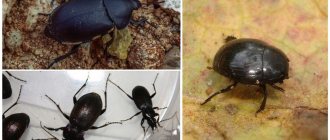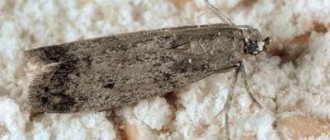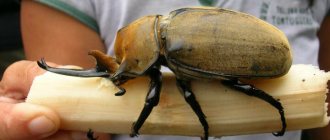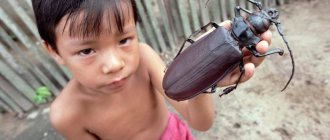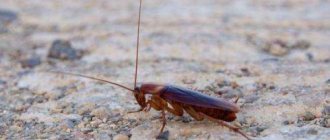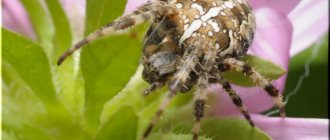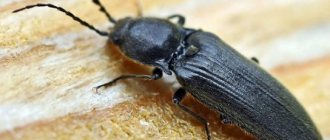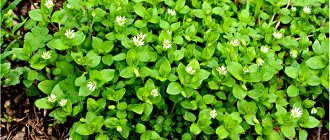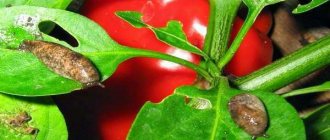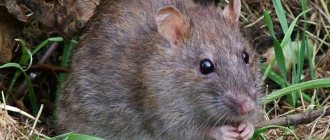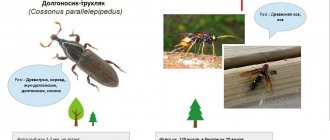In the struggle for the harvest in your garden plot, besides you, invisibly, but daily, numerous small but very important creatures take part - beneficial and harmful beetles, mites, butterflies, spiders, bedbugs, aphids and others. In a word - a variety of arthropods.
Some should be kicked out of the garden and dealt with in every possible way if we want our plants to feel good, but for others it would be worth creating all the conditions for a favorable existence - they can bring a lot of benefits.
How to figure out who is who and what to do with them? We will help.
Variety of beetles
The first beetles appeared on our Earth more than three hundred million years ago. These living creatures make up the largest group of insects. Imagine that the order consists of more than 350,000 different species.
Sixty percent of all beetles are representatives of just five families:
- Predatory beetles – 45,000.
- Ground beetles - 40,000.
- Weevils – 60,000.
- Barbels – 26,000.
- Leaf beetles – 35,000.
Insects have a wide habitat all over the world, sometimes settling even in our houses and apartments. In our article we want to look at some types of beetles.
Medvedka
The mole cricket is a large insect whose body length can reach 5 centimeters. The visual differences will be as follows:
- the size of the abdomen is 3 times larger than the cephalothorax;
- the abdomen may be soft in structure and may have a fusiform shape;
- diameter – 1 centimeter;
- At the end of the abdomen, paired thin thread-like appendages are visible.
The insect is primarily inclined towards an underground lifestyle. Despite this, it is capable of flying well, running on the ground and even swimming. The insect almost never gets to the surface of the earth. Even if a mole cricket gets to the surface, it happens in the dark.
May beetles
May beetles are quite common in our latitudes. Their appearance occurs in the spring - most often this occurs at the end of April. What types of cockchafers are known? In general, the entire genus is represented by 24 species, nine of which live in Russia. It is believed that the beetles appear with the budding of oak trees and the appearance of leaves on birch trees. If you look closely at the soil on warm spring days, you can see cockchafers crawling out after wintering. In the evenings, near the flowering green trees, you can hear the buzzing of insects. These are cockchafers. During the day you may not notice them on plants; they sit on leaves, clinging to them with their legs. It must be said that all types of cockchafers harm shrubs and trees, eating their greenery and flowers.
Chemicals
The most effective, but unsafe method of dealing with cockchafer larvae is the use of special chemicals. These preparations are used to treat the root system of seedlings and other planting material (bulbs, tubers, etc.). Their action is based on the penetration of poison into the intestines of insects through the underground parts of plants.
Agents against larvae
Preparations for cockchafer larvae and their effect:
- Antichrusch is a concentrated suspension containing imidacloprid and bifenthrin, which, once ingested by pests, has a negative effect on their nervous system, and is used when watering the soil around plants;
- Zemlin - acts through the digestion and intestines of insects and larvae with the help of the active substance diazinon;
- Aktara - the prepared solution is poured under the roots of plants to destroy the larvae;
- Pochin - added to the ground when sowing garden crops to poison underground pests;
- Nurell-D - the solution must be poured under the root, it is used for adult plants (shrubs and trees), penetrating with moisture into the root system, and then the poison enters the body of the larvae with food;
- Bazudin - added to the soil during planting, the granules contain diazinon, kills pests by contact-intestinal method after the poison enters through the roots and green parts of plants; however, poison should not be allowed to enter water bodies;
- Vallar - granules containing diazinon, dissolved in water intended for irrigation; the toxic substance penetrates the roots and cells of the plant and, after being eaten by the larvae, poisons them; You can also make a solution and dip the roots of the plants before planting.
If you take precautions and follow the recommendations specified in the instructions, all of the listed chemicals are not dangerous for plants, but they allow you to get rid of larvae living underground in your dacha or garden.
Appearance of the cockchafer
The body of the cockchafer reaches 2-3.5 centimeters in length. It is covered with a chitinous shell that protects the internal organs. We are accustomed to the fact that the insect has a light brown tint. But in nature, different types of beetles (photos are given in the article) can have different colors, from reddish brown to black. The shades depend on the habitat of the insects. Brown color is characteristic of those individuals that live in open sunny places, and black cover is characteristic of those living in shaded places, such as forests. The beetles live in Asia and Europe, preferring forest-steppe areas with young pine trees. But they also adapt quite well within the city limits, in artificial plantings of fruit trees.
Giant mole rat
This underground resident is ready to surprise with its size:
- the minimum body length is 25 centimeters, and the maximum is 35;
- weight reaches one kilogram.
Body color can be ocher-brown, gray-fawn or light. In any case, appearance cannot be considered pleasant.
The giant mole rat leads only an underground and sedentary lifestyle, and it tries to build multi-tiered passages. Cutters are used to make passages.
The average characteristics of underground residential facilities for the giant mole rat are provided:
- the diameter of the stern passages ranges between 11 and 16 centimeters;
- depth does not exceed 50 centimeters;
- sandy soil layers are used to make passages;
- Special emissions appear on the ground surface, made in the form of truncated cones. Moreover, their height is about 30 – 50 centimeters, and their weight is 10 kilograms;
- the length of the feed tunnels can be 500 meters;
- the tunnels include numerous additional objects that are located at a depth of no more than three meters. In this case, the underground inhabitant cannot approach more than 90 centimeters to the ground surface.
The giant mole rat is one of the most powerful and formidable inhabitants of the underground world. This proves the presence of terrible teeth that can even break a shovel.
The mole is an insectivorous and mammalian creature. In most cases, moles live in Eurasia, but they can also be found in North America.
The sizes of moles are surprising in their diversity:
- minimum length - 5 centimeters, maximum - twenty-one;
- weight - from nine to one hundred and seventy grams.
Moles are ideally adapted to an underground lifestyle, so they are ready to dig numerous passages.
Main visual differences:
- elongated body shape;
- the body is covered with thick and even fur, which can be velvety;
- The pile of a fur coat always grows straight.
Moles are able to successfully move underground in any direction, successfully making passages.
Unique insect abilities
May beetles fly at a speed of three meters per second - quite good for a small creature. In good weather conditions, they cover up to twenty kilometers per day. The flight altitude of the insect ranges from six to one hundred meters. The flight goal of all varieties of the cockchafer is always green spaces. The eastern insect prefers the nearest forest or tall trees. And western cockchafers orient themselves during flight to the highest objects in the distance, as a rule, these are forests.
A feature of these unique insects is their ability to find the right path. Studying the habits of the beetle, biologists caught them and moved them to a completely different place, releasing them after a couple of days. No matter how incredible it may seem, the insects took the same course, as if they were programmed to fly in a certain direction.
It is still unknown how beetles navigate. On the one hand, they determine the direction by the sun, but on the other hand, they fly perfectly even in the evening, when there is no sun. Apparently, polarized light is enough for them to understand where to move. Biologists even suggest that cockchafers are able to remember their surroundings, focusing on the most noticeable objects.
Field mice
Voles cause no less harm than earth rats. They spoil potato tubers and flower bulbs, and gnaw the roots and bark of trees and shrubs. Like other soil pests, mice dig holes, but the piles are much smaller, and the remains of gnawed roots can be found in them.
Voles often live in country houses
Under favorable conditions, they can bear offspring every month, multiplying exponentially. The only thing that can bring relief is the fact that not all voles survive in harsh winters.
Bark beetles
What are bark beetles? The species of these insects are very diverse. All of them live in vast areas, causing significant damage to plants, both growing and cut down. All these types of beetles are pests. These include:
- Dendrocton, or spruce beetle.
- Bark grinder beetle (furniture or house beetle).
- Birch sapwood.
- Shashel.
- Oak large black barbel.
- Xylophagous beetle.
- Typograph beetle. People call it the bark beetle.
- Woodboring beetle or house bark beetle (woodcutter).
melon aphid
Numerous scatterings of tiny green or black aphids can destroy many plantings of vegetable and berry crops.
Aphids settle in colonies. Feeding exclusively on plant sap, which they suck from young shoots, they poison plants with injected poison and can carry infections and viruses. In the absence of timely measures to destroy aphids, they can completely destroy most of the crop.
Methods for controlling aphids are carried out in several ways:
- mechanical, washing away insects with a stream of water;
- using a solution of wood ash and soap, decoctions of medicinal and other plants (tansy, yarrow, garlic, dandelion, tobacco, etc.);
- destruction of ant colonies that become carriers of aphids;
- chemical insecticides.
Melon aphids and spider mites
Wood-boring beetles
All species of this insect are common not only in forests, but also in all places where there are accumulations of wood. They easily appear in wooden houses, warehouses, cottages and even in wooden furniture. Since childhood, we have known another name for the insect - woodcutter beetle, or grinder.
Different types of pest beetles can cause a lot of trouble to the inhabitants of the house. As a rule, when building a house or cottage, wooden elements are not always treated with protective agents. If after a while you notice something wrong, or the floorboards are creaking, you should know that you have uninvited guests - wood-boring beetles. All types of household pests must be immediately destroyed, since they themselves will not leave you, but during their stay they will damage many wooden things, including floors, frames, and ceilings.
Woodworms have the characteristic feature of laying their larvae not in living wood, but in saw cuts. The beetle is very small in size - only a few millimeters. Almost all the time it is in wood, where its life takes place, and it prefers dry old wood. It must be said that the main damage is caused not by beetles, but by their larvae. After all, it is they who make passages in the boards, turning them almost into dust. It’s hard to imagine, but the larvae live from five to twenty years, gnawing through kilometers of tunnels. The woodworm itself is not capable of causing much damage. The beetles reproduce quickly, in the spring the females lay eggs, and after a week the larvae appear, feeding on the tree.
Gopher
The gopher is an underground dweller that can be found in Central America. It has the following dimensions:
- length – 9 – 35 centimeters;
- tail – 4 – 14 centimeters;
- weight – 1 kilogram.
In most cases, gophers live underground, and their housing most often includes complex underground passages. It is assumed that the passages are laid in different soil horizons. The length of the tunnels often reaches 100 meters.
Dendrocton, or spruce beetle
Dendroctons are common species of bark beetles. They can be found in Italy, England, Norway, and the countries of the Far East. The most suitable for them is taiga terrain; they rarely live in steppe areas. The pine beetle can make short flights. But the main way it spreads is through the transportation of contaminated wood.
The color of the pine beetle depends on its habitat; most often it is brown, black or brown. The body of the insect has an elongated oblong shape. And the mustache resembles a mace.
The female parasite lays eggs inside the wood; the hatched larvae, feeding, gnaw through entire networks of tunnels. Then they grow up and after a while lay their larvae.
Signs of nematode damage
- Strawberry . Reddish or yellow-brown spots appear on the leaves. Their petioles turn red and lose their edges. Gradually the leaves turn brown and then dry out or rot. Over time, the affected rosettes become deformed, and their central part dies.
- Potato . The plant produces few stems (1-3), the leaves on them are small, quickly turn yellow and dry out. Tubers practically do not set or there are very few of them.
- Onion. The plant has thick, curved feathers. Over time, they turn yellow and droop. The bulb inside is soft, loose, and rots quickly.
- Beet. The leaves of the plant turn brown and wither. The root crop lags behind in development and shows signs of rot.
- Chrysanthemums. These flowers are most often affected by nematodes. The first sign is the appearance of light yellow spots on the leaves, which gradually turn brown, dry out and fall off. The shoots become short and thickened. Plants either do not bloom at all or form small inflorescences. In addition to chrysanthemums, the nematode can attack asters, delphiniums, zinnias, phlox and begonias.
Grinder
Borers are parasites, like all types of bark beetles. The body of the insect is elongated, and the head is hidden under a kind of hood. It mainly has a brown or brown tint. The surface of his body is covered with down. The beetle can fly, and then colonizes large areas. Insects make mass migrations at the beginning of summer. Pests have their own defense mechanism, which is the ability to pretend to be dead.
Insects reproduce very quickly. Females make four clutches per year. Despite their modest size, beetles eat a lot.
Shrew
It looks like a mouse, only they have an elongated nose in the form of a proboscis.
The shrew ate the Ratobor grain bait
It feeds on larvae, earthworms and insects. Therefore, like a mole, it does not engage in deliberate sabotage. However, in the process of digging, it damages the root system of plants. Because of this, its proximity, despite the obvious benefits, is still unpleasant.
Birch sapwood
All types of beetles (photos are given in the article) - bark beetles - have an excellent appetite. Birch sapwood was no exception. His favorite delicacy is old birch trees. But during reproduction, the parasite will not ignore young trees. If such an insect settles in a tree, it will live no more than a few years and die.
The beetle gnaws holes in the wood, which provide ventilation for their home and become a site for fertilization of females. The length of the insect does not exceed 6.5 millimeters. There are spots on the wings. Beetles fly en masse at the beginning of summer. They are now found throughout Europe. What kind of wood do beetles prefer? Different types of birch trees of all ages become home to parasites. In addition to gnawing tunnels, beetles also infect trees with fungi. Since their body is covered with villi, they easily spread spores. Diseased trees gradually lose branches and then die.
Tuco – Tuco
Tuco-tuco are small rodents:
- weight – 700 grams;
- body length does not exceed 25 centimeters;
- The length of the tail is about eight centimeters.
Such sizes are direct evidence that tuco-tucos are ideally adapted to underground life. In addition, rodents are actually ready to build various residential objects from soil and sand, ideally adapted for the constant residence of a tuco-tuco.
Shashel
The shashel is medium in size and its body is painted white. In the neck area you can see black spots among the white fibers. It is difficult to say which types of bark beetles are most dangerous to plants. Moreover, larvae usually cause more harm than adults. The shashel larva makes numerous moves, very quickly the trunk turns into dust. It can live in a tree for up to several years, and then turns into a full-fledged beetle. Shashel has one feature that makes them difficult to detect. All holes made in the wood remain filled with wood flour. It does not spill out, and therefore it is externally difficult to determine infection with such a parasite.
Prevention measures
To prevent the appearance of the cockchafer and its larvae in your garden plot, the following preventive measures should be taken:
- regularly dig the soil deeply and then mulch it;
- in the spring months, a layer of crushed tree bark, straw or shavings should be laid on top of the soil - they will prevent female cockchafers from laying eggs;
- make grooves between crops in the garden, spilling them with karbofos solution;
- plant flowers of the cruciferous family, marigolds and lupins near plants, the smell of which always repels beetles and beetles;
- planting fodder turnips around the perimeter of the bed, burying cabbage leaves and green mustard shoots are folk techniques that help repel beetles;
- those who breed poultry can use the found larvae for feeding.
The cockchafer is one of the most dangerous pests of gardens and vegetable gardens. Only an integrated approach will help get rid of adult beetles and their larvae, which involves the use of both chemicals for treating garden crops and traditional methods of controlling and preventing the proliferation of pests.
Xylophage and typographer
A special feature of the xylophage is that its digestive tract contains fungi and bacteria that help break down wood. This parasite feeds on decaying fallen trees.
As for the typograph beetle, it destroys the forests of Kamchatka, the Far East, Europe, Sakhalin, and Siberia. He prefers trees with fairly thick bark, and the plant must be alive. An insect will never settle on a dead tree. Such bugs in the house are very dangerous. The types of wood do not matter much to them if they have chosen a wooden country house. From such a house, in just a year, only one piece of dust can remain. And because of its small size, the beetle is difficult to see, which is why it is so dangerous.
As we can see, all the representatives of bark beetles we examined are very dangerous beetles (species and names are indicated earlier), causing harm not only to homes, but also to large forest areas.
Earth rat
The largest representative of the vole family. However, this is where its similarities to mice end. She digs holes in the ground, and their entrances are quite noticeable. An earth rat can eat everything that grows in the garden - “from tops to roots,” and if it starts to starve, it will sneak into the house. It spoils crops, food, fruits, destroys bird nests, and gnaws the bark of trees. And this is only part of her “exploits”. And if you consider that this rodent has excellent fertility, then even if one mink is discovered, the gardener will have to prepare for a large-scale war.
Black beetles
It is believed that black beetles are the most dangerous for human habitation. The types of such insects are familiar to us from childhood: beetles, bark beetles, cockroaches. Whichever of these parasites settles in the house, you need to get rid of it urgently. But for the fight to be effective, we need to determine who our enemy is.
Khrushchak beetles are quite large in size: about two centimeters. But their larvae are very small, and therefore difficult to detect. They should be looked for in flour and cereals. These are their favorite places. Such spoiled products should be thrown away and the shelves should be treated with potassium permanganate or vinegar.
Black cockroaches may also appear in the house. Their danger is that they are carriers of viral diseases. While beetles and bark beetles die from insecticides, they have no effect on cockroaches. Therefore, experts recommend using the services of a sanitation service.
In order to protect yourself from the appearance of uninvited guests, you can periodically carry out preventive measures that will help keep insects out of your home. To do this, insecticides are again used, which are used to treat the back surfaces of cabinets, especially in the kitchen, baseboards, corners, and pantries. Sometimes it’s easier to prevent it from appearing than to get rid of it later.
Fighting methods
Of the beetle's enemies, it is worth noting starlings, sparrows, shrikes, beetles, storks, and hoopoes. The shrew destroys the larvae. Predatory flies and wasps can also help reduce insect numbers.
When using Metaphos, Chlorophos, Sumition, Decis extra 3 weeks before harvest, you can destroy up to 90% of pests. Among the drugs, Parachute, Karate Zeon, and Ephoria are also effective.
Folk remedies include spraying with vinegar solution and dusting with birch ash. Powder is usually applied in the morning. Ash is also sprinkled between the rows.
The largest beetles in the world
Once upon a time in childhood it seemed to us that cockchafers were very big. But in fact, there are much larger insects in the world. Let's look at some types of large beetles.
Titan is the largest insect (beetle) in the world. Biologists discovered an individual seventeen centimeters long, and in nature there are also twenty-centimeter giants. The habitat of such beetles is the Amazon rainforest. Females are larger in size than males. They live inside trees. With such impressive sizes, the beetles live only five weeks. Titan is simply a unique creature that does not even have close relatives. It belongs to the family of longhorned beetles, also called lumberjacks, which are distinguished by their beauty due to their large curved mustaches. The price of one such woodcutter beetle reaches five hundred dollars.
Animal behavior
Coleoptera have several behavioral features that are characteristic only of representatives of the species.
Acoustic abilities
Beetles chirp using their body.
About 20 families among all representatives communicate using sounds. There is a special stridulation apparatus for this. The sounds occur when the beetles move the mesothorax relative to the prothorax. Using sounds:
- representatives of different sexes meet;
- scare away predators;
- warn others about the threat.
Bioluminescent glow
Fireflies.
Fireflies and click beetles are distinguished by their ability to glow in the dark. This is possible thanks to special light organs on the abdomen. Some sternites contain substances that oxidize and appear bright.
This is also one of the ways of communication. This is how fireflies call females or males. Moreover, some do this as a signal for mating, and some predators lure males into a trap and eat them.
Distribution and habitat
Beetles are found everywhere without exaggeration. Insects do not live only in the glacial parts of the Arctic and Antarctic, but there are species that in the north have well adapted to the way of life, joining people. They live everywhere:
- in the upper layers of the soil;
- on the ground;
- on the grass;
- under the bark;
- in wood;
- on leaves;
- in flowers;
- in fruits;
- on the roots;
- in bodies of water;
- deserts and semi-deserts;
- anthills.
Protection Mechanisms
These insects have different types of mechanisms that are used for protection. Among them:
- Immobility . Many species pretend to be dead and fall motionless.
- Playfulness . This is running, jumping, swimming or flying. These species prefer to escape.
- Threats . Some species adopt intimidating postures and raise their mandibles to frighten the enemy.
- Noise . This method can serve as both protection from enemies and as a warning to others.
- Shades. The color itself is often camouflage, making the animals inconspicuous.
Food and natural enemies
Depending on the species, dietary preferences also differ. Beetles eat almost any organic matter. There are lovers of plants, animal food, fungal spores, decomposed parts of wood and organic matter. But there are individuals that have a mixed type of nutrition.
Among the natural enemies of Coleoptera there are a lot of different species of animals - mammals, arthropods and parasitic ichneumon wasps. The most common beetles eaten are:
- spiders;
- scorpions;
- centipedes;
- mice;
- rats;
- crows;
- magpies;
- mammals.
Many beetles become victims of humans. But most often they eat larvae, sometimes pupae.
Do skin beetle larvae bite humans?
There are many stories and reports of people being bitten by skin beetle larvae in their beds. Sometimes people find these pests directly on themselves, sometimes they wake up with bites on their bodies, inspect their sleeping place, find skin beetle larvae and think that these are the offenders.
It is impossible to say unequivocally whether skin beetle larvae bite a person or not. Theoretically, they can bite, but in fact they have no need for such attacks: both on the bed itself and near it there is always enough food for them. But it cannot be denied that, having stumbled upon the heel of a sleeping person in its travels, such a larva may well try to gnaw the skin on it.
On the other hand, the possibility of human error cannot be denied. Very often, people wake up, find a bite, or several bites, on themselves, begin to inspect the bed, find skin beetles peacefully gnawing hair and skin from their heels, and blame the bites on them. And somewhere in the cracks of the bed frames, bedbugs remain secluded and unnoticed, and the next night they will crawl out again and bite a person.
Wool blanket heavily infested with carpet beetles
We often encounter similar situations in our practice: a person calls us and asks us to come and poison the skin beetles. They, they say, bite him, he found them, poisoned and destroyed them all, and the bites appear again. We arrive, find bedbugs in his apartment, and remove them.
Often, by the way, people blame the skin beetle larvae in this way because they are afraid to admit that bedbugs live in their home. At least in our practice, more than half of people’s reports of skin beetle bites turned out to be mistakes, and the bites turned out to be bedbug bites.
On a note
Also, very often people report that they are bitten by carpet beetles. This is almost certainly a mistake: these bugs for the most part do not feed on anything at all, and therefore they will not even try to chew on a person.
At the same time, in many apartments and houses where we removed skin beetles, people complained that these insects were biting them, but we did not find anyone - no bedbugs, no fleas, no mosquitoes. That is, it is impossible to confidently deny the possibility of being bitten by skin beetles.
Life cycle features
Adult Colorado potato beetles spend the winter hibernating underground. In early spring, they move outside and begin to destroy only sprouted plants.
When the air temperature rises above ten degrees, the Colorado potato beetle begins its breeding season. In some cases, the beetles mate even before going to hibernation. Then they give birth immediately after waking up. The average lifespan of representatives of these insects is from one to three years.
The period of awakening and adaptation of beetles takes from one to one and a half months. If there is a food source, adult individuals quickly grow stronger and are ready to breed offspring.
The larvae emerge from the eggs a week after they are laid. The body of the larvae is fleshy, convex, and has a bright orange color. The main activity of these insects begins after the air temperature reaches 15 degrees.

